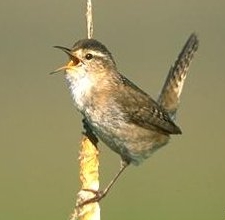Wildlife - Species

Short-billed Marsh Wren (Cistothorus platensis)
Description
The short-billed marsh wren, also known as the sedge wren, belongs to the family Troglodytidae. It is one of nine species of wrens found in North America. Wrens are generally small birds with short, upturned tails varying in color from brown to gray to buff. The short-billed marsh wren is small (10-11 cm or about 4 in) with fine streaks on top of the head and back and a pale eyebrow stripe. The bird's back is light brown, and its underside, chest, and sides are a cinnamon color.
Preferred Habitat and Biology
Short-billed marsh wrens breed from Saskatchewan, Manitoba, and New Brunswick to Kansas, Missouri, and Delaware. Winter ranges extend from southern Illinois and Virginia, and south to southeastern Mexico and southern Florida. In South Carolina, it is a fairly common winter resident over most of the state, although it is more numerous along brackish and freshwater marshes in coastal areas.
Like its relatives, the short-billed marsh wren has secretive habits and is therefore difficult to spot among the tall grasses where it lives. It also shares with other wrens the characteristic behavior of constructing several "dummy nests" or "false nests." Such nests are built during the breeding season but are used for roosting rather than breeding. Nests are a round-shaped mass of marsh grass lined with feathers woven into the upper portion of a thick stand of grass or sedge. Short-billed marsh wrens breed polygynously (one male mates with more than one female), although not all the time, and males sing prolifically throughout the breeding season. In South Carolina, eggs are usually laid in early June, sometimes as early as the end of April and as late as the beginning of August. Clutch size is five to seven white eggs that incubate for an average of 14 days, with the young fledging approximately 14 days after hatching. This species' diet consists almost exclusively of insects and spiders.
Species Significance
The short-billed marsh wren is not currently threatened or endangered and is a fairly common winter resident of the ACE Basin.
References
A guide to the Life in the Salt marsh poster. South Carolina Department of Natural Resources, Marine Resources Division.
Bull, J. L. and J. Farrand, Jr. 1995. National Audubon Society Field Guide to North American Birds. Eastern Region. The Audubon Society field guide series. Alfred A. Knopf Inc., New York, NY.
Crawford, R. D. 1977. Polygynous breeding of short billed marsh wrens. The Auk 94: 359-362.
Sprunt, A., Jr. and E. B. Chamberlain. 1970. South Carolina bird life. University of South Carolina Press, Columbia, SC.
